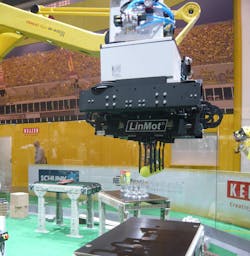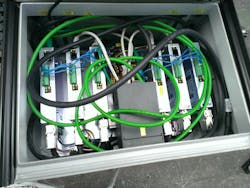Replacing Pneumatics with Electronic Motors Enhances Construction Gripper
In large machinery such as construction vehicles and pounding machines, pneumatics may be chosen over electric-motor actuation for their holding strength, energy density, and robustness in applications with high force ratings. Smaller cylinders may also be candidates for use in precision devices. However, designers often opt to use electric motors in sensitive applications that require a wide variation in force because they are easier to maintain and fine tune. This article outlines the observations made by designers at Keller HCW when they replaced pneumatic actuators on their robotic gripper with 12 electric motors from LinMot.
As demonstrated at the Automatica show in Munich this past spring, replacing pneumatic cylinders to direct-drive linear motors enables Keller HCW’s robotic grippers to safely pick up objects ranging from bricks to champagne glasses and tissue packs. In practice, the upgraded gripper is suitable for lifting and aligning bricks of various types during construction. The company also recognizes the upgrade for its improvements in functionality, maintenance, repeatability and precision, and energy efficiency.
With stroke adjustment restricted to a mere 10 mm, the use of pneumatic cylinders limited the gripper’s ability to grasp bricks of different sizes, shapes, and cross-sections. As a result, builders were required to switch out the grip ends between tasks, which increased work time and ultimately wasted worker and mechanical energy. The cost of four or five additional gripper types also contributed to the expenses of construction. It was proposed that a rotary servo drive be used to adjust the stroke length for improved variability in grasping, but this solution does not eliminate the problem of adjustment repeatability.
Since the behavior of the pneumatic cylinders is highly influenced by environmental factors such as air humidity and ambient temperature, it is extremely difficult to predict how the cylinders will react to any adjustments. By replacing the cylinders with motors, the system is less affected by the surroundings. They also respond to feedback and enable incremental adjustments with acceptable repeatability.
"Linear motors can be controlled more precisely and are more dynamic than pneumatic drives. They can also cover a much longer stroke in a short time," says the Keller specialist for automation and electrical engineering.
One may inquire whether the switch to electric motors from pneumatics affected the strength and holding force of the gripper. Though it’s been established that variability in strength is achieved by the motors, the designers ensure that force is not compromised. The design employs twelve PS01-37Sx120-HP-N LinMot motors that can achieve a maximum stroke of 120 mm with incremental stroke lengths, and a maximum force of 122 N with an especially compact form factor.
To reduce manual control, the motors are actuated via 12 ProfiNet servo controllers from LinMot’s C1100 series. The system includes a user interface so that brick arrangements can be directly inputted for automatic pick-and-place. The grip force and stroke length is controlled directly through the interface. The motors are positioned directly on the gripper jaws for a fairly compact and lightweight finished design. In the next model, Keller HCW plans to incorporate LinMot multi-axis modules or distributed motors with integrated drive electronics onto the gripper to further reduce the final product’s weight and space occupied on the gripper.
About the Author
Leah Scully
Associate Content Producer
Leah Scully is a graduate of The College of New Jersey. She has a BS degree in Biomedical Engineering with a mechanical specialization. Leah is responsible for Machine Design’s news items that cover industry trends, research, and applied science and engineering, along with product galleries. Visit her on Facebook, or view her profile on LinkedIn.



